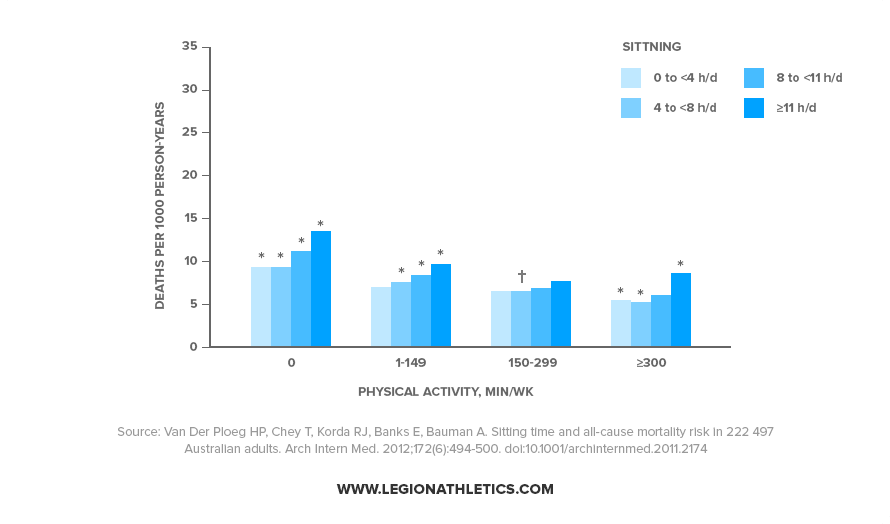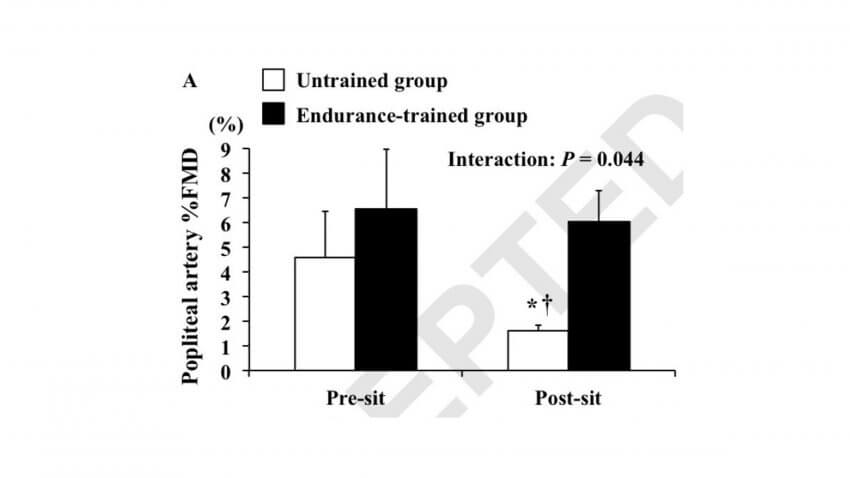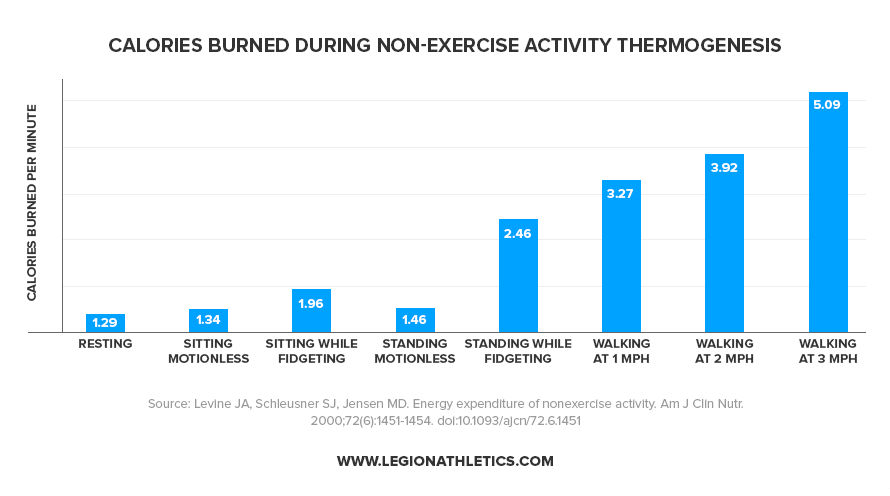Key Takeaways
- Research shows people who spend much of their day sitting have a higher risk of developing many different diseases and dying early.
- Although regular exercise can reduce the negative effects of sitting on your health, it doesn’t get rid of them completely.
- Keep reading to learn the four best ways to avoid the negative health effects of sitting (hint: it’s not just buying a standing desk!)
According to a study conducted by scientists at the Centers for Disease Control (CDC), twenty-six percent of U.S. adults report spending eight hours or more per day sitting on their kiesters, and forty-five percent report being “inactive.”
Given the mountain of evidence showing the health benefits of regular physical activity, the logical next question is, how bad is this for us?
Is sitting really the “new smoking,” as some people claim?
And is sitting still bad for us even if we’re active the rest of the time?
That is, can we counteract the negative effects of sitting by lifting weights, doing some cardio, and playing sports when we aren’t parked on our derrier’s?
None of these questions are easy to answer, and researchers, fitness gurus, and various health websites all seem to have a different opinion.
So, how bad is sitting for your health, really?
The short answer is that while sitting isn’t as bad for you as smoking, it is linked with serious health issues and an earlier death. What’s more, some research shows that sitting can be bad for you even if you work out regularly.
Want the long answer? Keep reading!
In this article, you’ll learn why people say sitting is so bad for you, how sitting actually impacts your health, whether or not sitting “cancels out” the benefits of working out, and evidence-based strategies for mitigating the negative effects of sitting.
Let’s get to it.
How Bad Is Sitting for Your Health, Really?

Researchers have long suspected that sitting is bad for our health.
In the first ever book written about occupational illness, De Morbis Artificum Diatriba, renowned physician and writer Bernadino Ramazzini observed as early as the 1600s that people who sat for the majority of their work day tended to be in worse health than those who were more active.
These “chair workers,” as he called them, experienced poor posture, low-back pain, and “general ill-health” at a higher rate than people in more vigorous professions.
Modern research supports this idea as well.
For example, a recent meta-analysis (a study of other studies) conducted by scientists at the University of Regensburg looked at how sitting impacted the risk of disease in 43 different studies. They found that on average, the more people sat each day, the higher their risk of colon, lung, and endometrial cancer.
When scientists at the University of Queensland looked at the association between sitting and overall life expectancy, they found that each hour of sitting per day was associated with a decrease in lifespan of 21 minutes and 48 seconds.
Here’s another way to look at it: sitting most of the day, which is the case for the majority of Americans, cuts years off your lifespan.
Scientists are still exploring exactly how sitting harms our health, but it seems to have something to do with metabolic changes that occur in our muscles when we don’t use them.
For instance, when you sit for long periods of time, your muscles produce less of the enzyme lipoprotein lipase (LPL). LPL is responsible for removing fat from the blood and maintaining healthy cholesterol levels, and when LPL levels drop, it can increase the risk of developing high cholesterol, triglycerides, atherosclerosis, and various other metabolic maladies.
Physical activity has the opposite effect—boosting LPL levels significantly higher above baseline. For example, one study in rodents found that leisurely treadmill walking raised LPL levels eight times higher than they are at rest.
When you remain still for long periods of time, your muscles also become less sensitive to the hormone insulin, which can increase the risk of diabetes, body fat gain, and metabolic syndrome.
Of course, you’ve probably heard much of this before.
There are endless studies showing the benefits of physical activity and sitting all day is, well, the polar opposite of being physically active. Thus, most people think the reason sitting is bad for your health is because it’s time not spent moving.
In economic terms, sitting represents an “opportunity cost” in the form of time that could be spent being active.
While that’s true as far as it goes, new research shows the negative effects of sitting go even deeper than this.
Summary: Sitting for long periods of time (6 to 8+ hours per day) is associated with a significantly higher risk of many diseases and an early death, and most of the negative effects seem to be caused by metabolic changes that occur inside the muscles when sedentary.
Why You Can’t Just “Exercise More” to Make Up for Sitting
At this point you’re probably thinking, I get it—sitting is bad for me—but what if I work out regularly?
What if I sit most of the week but get plenty of exercise on the weekends?
Or better yet, what if I sit most of the day but workout before or after work every day?
Will that protect me from the negative effects of sitting?
Kind of, but not really.
It turns out that sitting can even rob you of many of the health benefits of exercise.
For example, a study conducted by scientists at the University of Texas found that sitting for several days canceled out many of the health benefits of a one-hour run.
The researchers had ten untrained men and women aged 24 years old on average remain as sedentary as possible for four days. Specifically, they sat 13.5 hours per day on average, making sure they took fewer than 4,000 steps per day.
On the morning of the fifth day, the participants ate a large, high-carb, high-fat meal of melted ice cream mixed with half-and-half creamer (seriously). During the meal and over the next six hours, the researchers took a variety of blood tests to see how well the participants processed the influx of calories.
Specifically, they looked at how high blood glucose and triglyceride levels rose after consuming the meal.
Then, a week later, all of the participants completed the exact same protocol, but with a twist: on the evening of their fourth slothful day, they did a brisk one-hour run on the treadmill. The next morning, they again downed their melted ice cream milkshakes and the researchers took all of the same blood tests.
Normally, the health benefits of a one-hour run would persist for at least a day if not longer. Insulin sensitivity, glucose tolerance, and fat burning rise immediately and stay elevated for hours after a cardio workout. And when you eat a fatty or sugary meal after a workout—even hours later—your triglyceride and blood glucose levels don’t rise as much as they would when you’re sedentary, which is one of the ways exercise protects against heart disease.
Unfortunately for the participants in this study, they didn’t get any of these benefits.
After eating their ice cream slurry, the participants’ blood sugar, triglyceride, and insulin levels skyrocketed just as high regardless of whether or not they ran or remained sedentary during the four-day study.
That is, the one-hour run didn’t seem to confer any health benefits after four days spent mostly sitting, leading the authors to conclude that sitting causes “exercise resistance.”
Several studies over the past few years have also shown that sitting can increase your risk of several diseases regardless of how much you exercise the rest of the time. That is, sitting for six, eight, ten, or more hours per day can still negatively impact your health even if you work out regularly.
Here’s the key takeaway from all of this:
Watching T.V., typing at your desk, or playing video games for five hours at a stretch isn’t just bad for you because it means you aren’t getting enough exercise or burning enough calories. Prolonged, unbroken periods of sitting seem to harm your health in and of themselves.
For example, in a study conducted at the University of Sydney, scientists used accelerometers to track how much time 222,000 Australians spent sitting or exercising between 2006 and 2012.
Then, the researchers compared how the participants’ physical activity levels compared to their overall risk of dying during the course of the study.
Here’s a graph of the results:

As you’d expect, the researchers found that people who exercised the most had the lowest risk of dying, but they also found something more:
People who exercised the most but also spent more than 11 hours per day sitting had almost the same risk of dying as people who didn’t exercise but sat less than 4 hours per day.
What’s more, the researchers accounted for other variables that could have influenced the results such as body mass index (BMI), self-rated health, and educational status, increasing the chances it really was sitting that was to blame and not some other factor.
Another study conducted by scientists at the National Cancer Institute on 241,000 Americans found more or less the same result.
In this case, the researchers found that people who spent 7 hours or more per day watching T.V. (a proxy for sitting) and did vigorous exercise more than 7 hours per week had almost the same risk of dying as people who didn’t work out but spent less than 1 hour per day watching T.V.
In other words, “active couch potatoes,” as some researchers refer to these people, weren’t any better off than people who didn’t exercise but also didn’t sit much.
Based on these results, you could even argue that “sitting less” is just as important for your health as “working out more.”
Or as the authors of another paper on this topic put it, “sedentary behaviour (too much sitting) may be at least as important a public health problem as the lack of moderate- to vigorous-intensity physical activity (too little exercise).”
That all sounds pretty bad, but how bad is it really?
How much of the benefits of exercise are wiped out by sitting?
Well, a team of scientists at the University of Texas used accelerometer data from another study on 2,223 men and women to estimate what percentage of the benefits of exercise are wiped out by sitting.
After crunching the numbers, they estimated that one hour of exercise was required to offset every six hours of sitting. Or expressed another way, each hour of sitting negates about sixteen percent of the health benefits of an hour of light exercise, like walking.
More intense exercise, like brisk running, cycling, or swimming, was slightly better in this regard, with each hour of sitting only negating about eight percent of the health benefits of an hour-long workout (they didn’t look at strength training, but the results would probably be similar).
According to the results of this paper, if you sit for twelve hours per day, you’d need to do two hours of light exercise or one hour of intense exercise to mitigate the negative effects.
In other words, sitting for a good chunk of the day seemed to wipe out most of the health benefits of exercise.
Or, if you prefer the glass is half full perspective, you could say that an hour or two of light to intense exercise is enough to offset the negative health effects of an entire day of sitting.
Of course, many people have criticized the results, and for good reason. The authors of this study only looked at one measure of fitness, your Vo2max, and didn’t look at other positive effects of exercise like improved insulin sensitivity, triglyceride and cholesterol levels, and so forth.
In reality, there are many aspects of your fitness that don’t disappear after a few hours of sitting.
For example, there’s little evidence that sitting negates the muscle-building effects of strength training, or cardio’s ability to lower your blood pressure. You don’t lose neuromuscular adaptations, like being able to fire your muscle fibers during a back squat, just because you spend a few hours on your butt every day.
Other research shows that you may be able to avoid (or at least minimize) some of the negative effects of sitting by just working out harder and longer.
For example, one of the ways sitting damages your health is by reducing the ability of your blood vessels to expand and contract in response to changes in blood flow, or what’s known as flow-mediated dilation.
Healthy blood vessels are supple, and can easily widen or narrow to maintain a healthy blood pressure. When your blood vessels become stiffer and less supple, they don’t respond as efficiently to changes in blood flow, which can cause excess wear and tear on your heart and arteries over time.
You can measure flow-mediated dilation by constricting a blood vessel with a cuff (the same kind the doctor uses to measure your blood pressure), releasing the pressure, and then measuring how much the blood vessels expand afterward.
In sedentary people, there’s a significant drop in flow-mediated dilation after several hours of sitting, but at least one study shows this isn’t the case in well-trained athletes.
In this study, scientists from Hosei University measured the flow-mediated dilation of ten high-level endurance athletes on the university cycling team and nine healthy but inactive university students. They measured both groups’ flow-mediated dilation before and after three hours of sitting and compared the results, which you can see here:

After three hours of sitting, the non-athletes experienced a 67 percent drop in flow-mediated dilation, whereas the endurance athletes only experienced about a 4 percent drop.
That is, high-level endurance training seemed to inoculate the athletes from one of the negative cardiovascular side effects of sitting. They don’t call it “cardio,” for nothin’, after all.
Not all studies have found the same result, though.
For example, a pair of studies conducted by scientists at Virginia Commonwealth University found that recreational endurance athletes still experienced a significant drop in flow-mediated dilation after several hours of sitting.
But here’s the rub: although these people worked out, they weren’t that fit.
Their average Vo2Max—a measure of aerobic fitness—was only about 50 ml/kg/min, which is above average but nothing to write home about.
The average Vo2Max of the cyclists in the Hosei University study was 61 ml/kg/min, which is considered “excellent” for their age. These people were averaging over 1,500 miles of cycling per month (probably around 20 hours of training per week), and had been cycling at a high level for at least five years.
On the one hand, that’s obviously not a practical solution for most of us. On the other hand, it shows you probably can avoid some of the negative effects of sitting if you’re willing to train harder and longer than most people. You may not have time to make cycling your part-time job, but sneaking in an extra 30 to 60 minutes of vigorous exercise here and there will pay dividends over time.
So, while you can’t necessarily weigh the negative effects of sitting against the positive effects of exercise with the same precision you’d use to balance your checking account, the central message of all this research is clear:
Sitting for a good chunk of the day seems to have some direct negative effects on your health that you can’t completely “make up” for with exercise.
Even if you do a lot of vigorous exercise, you probably still spend the vast majority of your day not working out, and how active or inactive you are during this time can have a major impact on your health.
Summary: Sitting for long periods of time seems to offset some of the health benefits of exercise, and research suggests that sitting less may be just as important as working out more for maximizing your health.
But … Can’t You Just Buy a Standing Desk?

At this point you may be wondering, why not just buy a standing desk?
If sitting is the problem, and you spent most of your time sitting while working, why not just stand while you’re working instead?
It’s a nice theory, but it doesn’t quite work out in practice.
Using a standing desk can help offset some of the negative effects of sitting, although not for the reasons most people think.
On the one hand, using a standing desk forces your muscles to work a little harder and helps you burn a few more calories than sitting.
On the other hand, research shows that standing for long periods of time can cause many of the same health problems as sitting for long periods of time, and doesn’t burn as many calories as people think.
So, what’s wrong with standing?
Let’s start with the obvious—it’s tiring.
“Standing, even for a short time,” wrote Bernadino Ramazzini, “proves so exhausting compared with walking and running, though it be for a long time.”
This is something I’ve experienced personally and noticed talking with others who work at a standing desk: it feels disproportionately more fatiguing than it should.
For one thing, your feet quickly get sore unless you constantly change positions. I’ve found that I have to shift my weight from one foot to the other like a flamingo every five to ten minutes to stay comfortable, and this also forces me to lean my torso to one side or the other, eventually making my hips and back sore.
Talk with anyone who works in a job that has them on their feet all day—cooks, surgeons, teachers, and so forth—and they’ll tell you more or less the same thing: standing all day is exhausting.
But, surely there must be a silver lining here?
After all, things that are more difficult are often more rewarding.
Standing for long periods might be uncomfortable, but at least you’re improving your health instead of damaging it by sitting, right?
Unfortunately, that doesn’t seem to be the case.
Standing for long periods of time is also associated with some not-so-pleasant health effects, including varicose veins, back pain, poor posture, reduced circulation, and even “spontaneous abortions” in pregnant women.
Standing also doesn’t burn as many calories as most people think.
For example, a study conducted by scientists at the Mayo Clinic Foundation found that you actually burn more or less the same number of calories sitting still versus standing still, and about 25 percent more calories sitting while fidgeting (like shaking your knees, tapping your heels, etc.) than you do while standing completely still.
Standing while fidgeting burned the most calories, but that’s not very practical. Try tapping your feet while typing at a standing desk and you’ll see what I mean.
Here’s a graph showing the results of the study:

So, if sitting all day is bad for you … and standing all day is bad for you … what are you supposed to do?
Well, it turns out that it’s not sitting or standing that are problematic, per se, but lack of movement in general.
That is, sitting or standing in the same position for long periods of time is probably equally bad for your health, and the solution is the same in both situations: continuously change your posture throughout the day.
Ramazinni identified this problem in his patients as well, quipping “… the common maxim “Nothing to excess” is one that I excessively approve.”
In other words, don’t spend too much time in one position before taking a break and moving around a bit.
So, circling back to the topic of standing desks—they can be helpful if they allow you to periodically change your posture throughout the day.
In other words, you don’t just want a standing desk, which forces you to remain on your feet all day. Instead, you want a sit-stand desks or adjustable standing desk, which may help mitigate some of the negative effects of maintaining the same posture for hours on end.
Summary: Standing for long periods of time may be just as bad for your health as sitting for long periods of time, but changing your posture periodically (like you can do with a sit-stand desk), may help you avoid the negative effects of maintaining the same posture all day.
4 Evidence-Based Ways to Avoid the Negative Effects of Sitting

At this point, you know that sitting for prolonged periods of time is bad for you.
You also know that sitting can negate many of the benefits of regular exercise.
And you know that standing for long periods of time may be just as bad.
So, what are you supposed to do about all of this?
Well, as a general rule, you want to avoid maintaining the same position for extended periods of time throughout the day, and intersperse periods of sitting or standing with some physical activity.
Here are a few ways to achieve this:
1. Break up long periods of sitting or standing with periodic walks and other activities.
Taking frequent, brief breaks from sitting or standing, can mitigate most of their negative effects.
For example, you could set a timer so that every 45 minutes you get up from your desk and go for a short walk, knock out a few sets of a home workout, or do some chores around the house.
This is also what I do personally.
I spend at least four or more hours per day writing, which is all butt-in-chair time (I don’t stand when writing). Roughly every hour or so, I’ll get up, and do three to four sets of some kind of home exercise like pushups, squats, curls, etc.
This not only serves as a respite from sitting, but it also allows me to squeeze in what adds up to a ~45-minute workout throughout the day.
If I finish all of my sets or just don’t feel like doing strength training during my breaks, I’ll go for a short walk, tidy up my office, clean dishes, or do something else that’s productive but still involves movement.
2. Alternate between sitting and standing throughout the day.
One of the most effective ways to avoid the negatives of both prolonged sitting and standing is to … wait for it … switch back and forth between sitting and standing.
You’ll need an adjustable standing desk or another system that allows you to pull this off (before I had a standing desk, I’d put a small coffee table on top of my normal desk so I could work and stand).
The key to doing this right is to alternate frequently between sitting and standing throughout the day. That is, instead of spending 5 hours sitting, then 4 hours standing, a better option would be to spend 50 minutes sitting, 10 minutes standing; or 30 minutes sitting, 15 minutes standing, or some similar frequency.
That said, even if you alternate between sitting and standing throughout the day, you should still make sure you take some breaks for more vigorous activities that have you moving around, like walking, bodyweight exercises, chores, etc.
3. Exercise more.
Although sitting does negate some of the benefits of regular exercise, it doesn’t cancel them out entirely.
Or looked at from another perspective, you can cancel out many (but not all) of the negative effects of sitting by exercising a lot.
How much?
Well, as a rule of thumb, some is better than none and more is better than less, but a good starting point would be to get at least 30 minutes of moderate to intense exercise every day.
Better still would be something like three to five strength training workouts per week, along with two to four cardio workouts per week.
If you’re also lifting weights, most of these cardio workouts should be low to moderate intensity, with no more than one or two high-intensity cardio workouts per week.
Check out these articles to learn more about what kind of strength and cardio workouts you should do to maximize your health and fitness:
⇨ The Best Home Workout Routines for When You Can’t Go to the Gym
⇨ The Definitive Guide to Strength Training: How to Get Strong…Fast
⇨ The Definitive Guide on How to Build a Workout Routine
⇨ The Easiest Cardio Workout You Can Do (That Actually Works)
⇨ The Top 3 Reasons to Do High-Intensity Interval Training (HIIT)
4. Minimize unnecessary chair time.
If you find yourself with a few spare minutes, or you’re taking a break from work, try to find a way to spend your time that doesn’t involve sitting.
For example, if you normally take a few breaks during the day to shop online, surf news outlets, watch YouTube videos, or peruse social media, take that time to go on a walk and listen to a podcast or audiobook or call a friend.
If you normally relax in the evenings by vegetating in front of the T.V., play a board game, solve a puzzle, or do something that involves at least a little movement (even if you’re still sitting).
And if you spend a good chunk of your free time watching T.V., playing video games, surfing the web, or durdling around on social media, find a way to minimize these habits as much as possible. (Cal Newport’s book, Deep Work, has lots of helpful hints on how to do this).
The Bottom Line on Sitting and Your Health

Sitting isn’t the new smoking, but it’s also not harmless, either.
People who spend the majority of their day sitting have a significantly higher risk of cancer, heart disease, and death from all causes than people who sit the least.
What’s more, this is true even for people who exercise regularly.
That is, “active couch potatoes,” who spend a lot of time sitting but also work out vigorously, have a higher risk of dying than people who work out regularly but sit very little.
The main reason for this is that prolonged periods of inactivity cause metabolic changes in the muscles that increase the risk of a variety of diseases.
The good news is that most of these metabolic changes can be reversed if you take frequent breaks from sitting throughout the day and are willing to work out a bit harder and longer. Research shows that high-level athletes, for instance, seem immune to some of the health problems caused by sitting.
Although standing desks have become the most popular way to combat the downsides of sitting, they can cause many of the same problems. In reality, it’s not sitting that’s bad for you, per se, but maintaining any position for long periods of time (whether that’s sitting, standing, or lying down).
The best ways to avoid this problem are to …
- Break up long periods of sitting or standing with walks and other activities
- Alternate between sitting and standing throughout the day
- Exercise more
- Minimize unnecessary chair time
Follow that plan consistently, and you probably won’t have to worry about any negative effects of sitting (or standing).
What’s your take on the negative effects of sitting? Have anything else to share? Let me know in the comments below!
Scientific References +
- Fenster, L., Hubbard, A. E., Windham, G. C., Waller, K. O., & Swan, S. H. (1997). A prospective study of work-related physical exertion and spontaneous abortion. Epidemiology, 8(1), 66–74. https://doi.org/10.1097/00001648-199701000-00011
- Waters, T. R., & Dick, R. B. (2015). Evidence of health risks associated with prolonged standing at work and intervention effectiveness. Rehabilitation Nursing, 40(3), 148–165. https://doi.org/10.1002/rnj.166
- Tissot, F., Messing, K., & Stock, S. (2009). Studying the relationship between low back pain and working postures among those who stand and those who sit most of the working day. Ergonomics, 52(11), 1402–1418. https://doi.org/10.1080/00140130903141204
- Tüchsen, F., Hannerz, H., Burr, H., & Krause, N. (2005). Prolonged standing at work and hospitalisation due to varicose veins: A 12 year prospective study of the Danish population. Occupational and Environmental Medicine, 62(12), 847–850. https://doi.org/10.1136/oem.2005.020537
- Bernardino Ramazzini. (n.d.). VOICES FROM THE PAST . Retrieved from https://ajph.aphapublications.org/doi/pdf/10.2105/AJPH.91.9.1382
- Garten, R. S., Darling, A., Weggen, J., Decker, K., Hogwood, A. C., Michael, A., … Mcintyre, A. (2019). Aerobic training and vascular protection: Insight from altered blood flow patterns. Experimental Physiology, 104(9), 1420–1431. https://doi.org/10.1113/EP087576
- Morishima, T., Tsuchiya, Y., Ueda, H., Tsuji, K., & Ochi, E. (2020). Sitting-induced Endothelial Dysfunction Is Prevented in Endurance-trained Individuals. Medicine & Science in Sports & Exercise, 1. https://doi.org/10.1249/mss.0000000000002302
- Morishima, T., Restaino, R. M., Walsh, L. K., Kanaley, J. A., Fadel, P. J., & Padilla, J. (2016). Prolonged sitting-induced leg endothelial dysfunction is prevented by fidgeting. American Journal of Physiology - Heart and Circulatory Physiology, 311(1), H177–H182. https://doi.org/10.1152/ajpheart.00297.2016
- Kulinski, J. P., Khera, A., Ayers, C. R., Das, S. R., De Lemos, J. A., Blair, S. N., & Berry, J. D. (2014). Association between cardiorespiratory fitness and accelerometer-derived physical activity and sedentary time in the general population. Mayo Clinic Proceedings, 89(8), 1063–1071. https://doi.org/10.1016/j.mayocp.2014.04.019
- Dunstan, D. W., Healy, G. N., Sugiyama, T., & Owen, N. (2009). “Too much sitting” and metabolic risk - Has modern technology caught up with us? US Endocrinology, 5, 29–33. https://doi.org/10.17925/EE.2010.06.00.19
- Matthews, C. E., George, S. M., Moore, S. C., Bowles, H. R., Blair, A., Park, Y., … Schatzkin, A. (2012). Amount of time spent in sedentary behaviors and cause-specific mortality in US adults. American Journal of Clinical Nutrition, 95(2), 437–445. https://doi.org/10.3945/ajcn.111.019620
- Van Der Ploeg, H. P., Chey, T., Korda, R. J., Banks, E., & Bauman, A. (2012). Sitting time and all-cause mortality risk in 222 497 Australian adults. Archives of Internal Medicine, 172(6), 494–500. https://doi.org/10.1001/archinternmed.2011.2174
- Ramírez-Vélez, R., Correa-Rodríguez, M., Tordecilla-Sanders, A., Aya-Aldana, V., Izquierdo, M., Correa-Bautista, J. E., … Garcia-Hermoso, A. (2018). Exercise and postprandial lipemia: Effects on vascular health in inactive adults. Lipids in Health and Disease, 17(1), 69. https://doi.org/10.1186/s12944-018-0719-3
- Nystoriak, M. A., & Bhatnagar, A. (2018, September 28). Cardiovascular Effects and Benefits of Exercise. Frontiers in Cardiovascular Medicine. Frontiers Media S.A. https://doi.org/10.3389/fcvm.2018.00135
- Akins, J. D., Crawford, C. K., Burton, H. M., Wolfe, A. S., Vardarli, E., & Coyle, E. F. (2019). Inactivity induces resistance to the metabolic benefits following acute exercise. Journal of Applied Physiology, 126(4), 1088–1094. https://doi.org/10.1152/japplphysiol.00968.2018
- Kim, K. S., Kim, S. J., Kim, S., Choi, D. W., Ju, Y. J., & Park, E. C. (2018). Association of self-reported sedentary time with insulin resistance among Korean adults without diabetes mellitus: A cross-sectional study. BMC Public Health, 18(1), 1335. https://doi.org/10.1186/s12889-018-6237-4
- Dempsey, P. C., Larsen, R. N., Winkler, E. A. H., Owen, N., Kingwell, B. A., & Dunstan, D. W. (2018). Prolonged uninterrupted sitting elevates postprandial hyperglycaemia proportional to degree of insulin resistance. Diabetes, Obesity and Metabolism, 20(6), 1526–1530. https://doi.org/10.1111/dom.13254
- Bey, L., & Hamilton, M. T. (2003). Suppression of skeletal muscle lipoprotein lipase activity during physical inactivity: a molecular reason to maintain daily low-intensity activity. The Journal of Physiology, 551(2), 673–682. https://doi.org/10.1113/jphysiol.2003.045591
- Wang, Y., & Xu, D. (2017, July 5). Effects of aerobic exercise on lipids and lipoproteins. Lipids in Health and Disease. BioMed Central Ltd. https://doi.org/10.1186/s12944-017-0515-5
- Kobayashi, J., & Mabuchi, H. (2015, November 1). Lipoprotein lipase and atherosclerosis. Annals of Clinical Biochemistry. SAGE Publications Ltd. https://doi.org/10.1177/0004563215590451
- Pirahanchi, Y., & Sharma, S. (2019). Biochemistry, Lipoprotein Lipase. StatPearls. StatPearls Publishing. Retrieved from http://www.ncbi.nlm.nih.gov/pubmed/30725725
- Yokoyama, M., Seo, T., Park, T., Yagyu, H., Hu, Y., Ni, H. S., … Goldberg, I. J. (2007). Effects of lipoprotein lipase and statins on cholesterol uptake into heart and skeletal muscle. Journal of Lipid Research, 48(3), 646–655. https://doi.org/10.1194/jlr.M600301-JLR200
- Mead, J. R., Irvine, S. A., & Ramji, D. P. (2002, December). Lipoprotein lipase: Structure, function, regulation, and role in disease. Journal of Molecular Medicine. https://doi.org/10.1007/s00109-002-0384-9
- Hamilton, M. T., Hamilton, D. G., & Zderic, T. W. (2007, November 1). Role of low energy expenditure and sitting in obesity, metabolic syndrome, type 2 diabetes, and cardiovascular disease. Diabetes. American Diabetes Association. https://doi.org/10.2337/db07-0882
- Yang, L., Cao, C., Kantor, E. D., Nguyen, L. H., Zheng, X., Park, Y., … Cao, Y. (2019). Trends in Sedentary Behavior among the US Population, 2001-2016. JAMA - Journal of the American Medical Association, 321(16), 1587–1597. https://doi.org/10.1001/jama.2019.3636
- Veerman, J. L., Healy, G. N., Cobiac, L. J., Vos, T., Winkler, E. A. H., Owen, N., & Dunstan, D. W. (2012). Television viewing time and reduced life expectancy: A life table analysis. British Journal of Sports Medicine, 46(13), 927–930. https://doi.org/10.1136/bjsports-2011-085662
- Schmid, D., & Leitzmann, M. F. (2014). Television viewing and time spent sedentary in relation to cancer risk: a meta-analysis. Journal of the National Cancer Institute, 106(7). https://doi.org/10.1093/jnci/dju098
- Ussery, E. N., Fulton, J. E., Galuska, D. A., Katzmarzyk, P. T., & Carlson, S. A. (2018, November 20). Joint prevalence of sitting time and leisure-time physical activity among US adults, 2015-2016. JAMA - Journal of the American Medical Association. American Medical Association. https://doi.org/10.1001/jama.2018.17797










